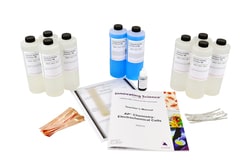Learn More
Innovating Science™ AP Chemistry Kits: Electrochemical Cells

Shop All Aldon Products

Description
Includes
Materials for 15 groups: 500mL Cupric Sulfate, 0.5M solution (2); 25mL Bromothymol Blue, 0.04% solution; 500mL Sodium Sulfate, 1M solution (8); Copper metal strips (15); Magnesium metal strips 5 in. UN1869 (15); Dialysis tubing strips 6 in. (15); teacher's guide; and student copy masters
The tendency of oxidation-reduction reactions is to proceed to an equilibrium state. In electrochemical cells, these reactions provide another way for us to express the driving force in chemical reactions.
When reagents that accept or donate electrons are arranged so that the electrons can enter or leave the reaction through a metallic conductor, an electrochemical cell is established. A half-cell contains a metal in contact with a solution of its salt. Each metal will develop a different electrical potential based on its electron configuration.
The standard reduction potential listed in various references is the voltage that a half-cell develops when combined with a hydrogen half-cell. First, construct a simple chemical battery and determine from the standard reduction potentials what the output of the battery will be (if a voltmeter is available the actual and theoretical voltages can be compared). Second, construct an electrolysis cell and demonstrate how hydrogen and oxygen can be produced from the electrolysis of water.
- Electrolysis cell is the reverse of a battery where a voltage higher than the reversible electromotive force of the cell is applied to the electrodes
- In a cell containing water and an electrolyte, the oxidation reaction occurring at the anode produces oxygen gas while the reduction occurring at the cathode produces hydrogen gas
- By the addition of a pH indicator, the oxidation-reduction reactions can be monitored visually
- Gases produced are collected in inverted test tubes and the volumes of hydrogen and oxygen are compared
Specifications
Specifications
| Certifications/Compliance | 49 CFR 173.4 |
| Product Type | Electrochemical Cells Chemistry Kit |
| Color | White |
| Grade | 7 to 14 |
| Age | 13 to 20 |
| For Use With (Application) | To study electrolysis of water produces hydrogen and oxygen |
| Includes | 2 x 500mL Cupric Sulfate, 0.5M solution, 1 x 25mL Bromothymol Blue, 0.04% solution, 8 x 500mL Sodium Sulfate, 1M solution, Copper Metal strips, Magnesium Metal strips 5 in., dialysis tubing strips 6 in., teacher's guide and student study guide copymasters |
| Quantity | 1 |
| Dimensions (L x W x H) | 10.25 x 10.25 x 8.5 in. |
| Class Size | 15 Lab Groups |
Your input is important to us. Please complete this form to provide feedback related to the content on this product.
